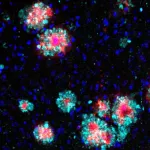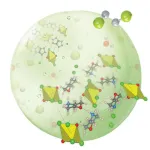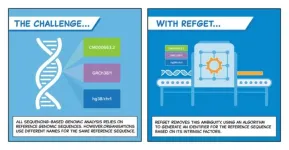(Press-News.org) Alzheimer’s is considered a disease of old age, with most people being diagnosed after 65. But the condition actually begins developing out of sight many years before any symptoms emerge. Tiny proteins, known as amyloid-beta peptides, clump together in the brain to form plaques. These plaques lead to inflammation and eventually cause neuronal cell death.
Interplay of proteins in the brain reveals disease mechanism
Exactly what triggers these pathological changes is still unclear. “We’re lacking good diagnostic markers that would allow us to reliably detect the disease at an early stage or make predictions about its course,” says Professor Erich Wanker, head of the Proteomics and Molecular Mechanisms of Neurodegenerative Diseases Lab at the Max Delbrück Center. Wanker and his team are studying brains with Alzheimer’s disease to understand their proteome – the interplay between all the proteins involved in the onset and course of the disease. Writing in Genome Medicine, the researchers now report on a new actor in the pathological process. Their discovery will help scientists understand the mechanisms underlying Alzheimer’s and could also serve as a marker for improved diagnostics.
To analyze changes in the proteome, Wanker’s team studies genetically modified mice. The mice have five mutations that occur in people with familial Alzheimer’s disease. The amyloid-beta plaques develop in the mice’s brains and the animals show typical symptoms, such as dementia.
New perspectives for a better understanding of Alzheimer’s
“During our analyses, we noticed that a protein called Arl8b was building up in mouse brains, along with the amyloid-beta plaques,“ says Annett Böddrich, lead author of the paper. The researchers also found accumulations of the protein in brain samples from Alzheimer’s patients.
Arl8b is associated with lysosomes, cell organelles that are involved in degrading the protein clumps. A different team of researchers recently made an interesting discovery in the nematode worm: increasing Arl8b production can degrade the plaques, which reduces the damage to nerve cells. Closer study of Arl8b could be the key to better understanding Alzheimer’s disease – and could provide a new target for therapies.
Interesting candidate for a diagnostic marker
But there’s more: “We can show that Alzheimer’s patients have significantly more Arl8b in their cerebrospinal fluid than healthy controls,” says Böddrich. Unlike brain tissue, cerebrospinal fluid is easily accessible for diagnostic studies. “This means Arl8b is an interesting candidate for a diagnostic marker,” she says.
However, the study only looked at a small group of Alzheimer’s patients, so expectations should be kept in check: “It’s too early to hope for a diagnostic test,” says Wanker. Nevertheless, he is optimistic: “Our work shows that proteomic research can provide crucial information for identifying disease mechanisms and markers, and thereby move research forward. Also, this doesn’t just apply to Alzheimer’s; it’s also relevant to other complex neurodegenerative diseases such as Parkinson’s and Huntington’s.”
Further information
How misfolded proteins harm our brain
Misfolding in the Alzheimer’s brain
Wanker lab
Max Delbrück Center
The Max Delbrück Center for Molecular Medicine in the Helmholtz Association (Max Delbrück Center) is one of the world’s leading biomedical research institutions. Max Delbrück, a Berlin native, was a Nobel laureate and one of the founders of molecular biology. At the locations in Berlin-Buch and Mitte, researchers from some 70 countries study human biology – investigating the foundations of life from its most elementary building blocks to systems-wide mechanisms. By understanding what regulates or disrupts the dynamic equilibrium of a cell, an organ, or the entire body, we can prevent diseases, diagnose them earlier, and stop their progression with tailored therapies. Patients should benefit as soon as possible from basic research discoveries. The Max Delbrück Center therefore supports spin-off creation and participates in collaborative networks. It works in close partnership with Charité – Universitätsmedizin Berlin in the jointly run Experimental and Clinical Research Center (ECRC), the Berlin Institute of Health (BIH) at Charité, and the German Center for Cardiovascular Research (DZHK). Founded in 1992, the Max Delbrück Center today employs 1,800 people and is funded 90 percent by the German federal government and 10 percent by the State of Berlin.
END
A potential new biomarker for Alzheimer’s
2023-07-20
ELSE PRESS RELEASES FROM THIS DATE:
A non-covalent bonding experience
2023-07-19
UPTON, NY—Putting a suite of new materials synthesis and characterization methods to the test, a team of scientists from the University of Iowa and the U.S. Department of Energy's (DOE) Brookhaven National Laboratory has developed 14 organic-inorganic hybrid materials, seven of which are entirely new. These uranium-based materials, as well as the detailed report of their bonding mechanisms, will help advance clean energy solutions, including safe nuclear energy. The work, currently published online, was recognized as both a Very Important Paper and a Hot Topic: Crystal Engineering in ...
Research analyzes kidney functions and predictors of disease
2023-07-19
Research is shedding light on kidneys, their critical functions, and predictors of disease.
The research co-led by Matthias Kretzler, M.D. describes the creation of a cellular atlas of the kidney describing nearly 100 cell types and states. It represents the most comprehensive study of cellular states, neighborhoods, and outcome-associated signatures in the kidney.
Researchers from more than twenty institutions collaborated on this project.
Kidneys monitor and maintain the internal balance in the body, filter out ...
SARS-CoV-2 infects liver, stimulating glucose production and contributing to severe form of COVID-19
2023-07-19
Research conducted at the University of São Paulo (USP) in Brazil shows that SARS-CoV-2, the virus that causes COVID-19, can infect liver cells (hepatocytes), stimulating glucose production and leading to a condition similar to diabetes (hyperglycemia) in hospitalized patients, even if their blood sugar level was normal before they were admitted to hospital.
An article on the study is published in Proceedings of the National Academy of Sciences (PNAS). The findings describe part of the mechanism used by the virus to infect liver cells and impair glucose metabolism, and point ...
Research could pave way to greener, more sustainable products made with renewable carbon
2023-07-19
Carbon-based materials have several qualities that make them attractive as catalysts for speeding up chemical reactions. They are low-cost, lightweight and their high surface area provides a good scaffold on which to anchor catalysts, keeping them stable and dispersed far apart, while providing molecules a lot of surface area to work. This makes carbons useful for energy storage and sensors. Over the last 10 years, carbons have been used in electrochemistry to catalyze reactions to make chemicals and fuel cells.
However, ...
Unlocking the power of molecular crystals: a possible solution to nuclear waste
2023-07-19
In a world increasingly concerned about the environmental and geopolitical implications of fossil fuel usage, nuclear energy has resurfaced as a subject of great interest. Its ability to generate electricity at scale without greenhouse gas emissions holds promise as a sustainable clean energy source that could bridge society’s transition away from fossil fuels to a net-zero future. However, nuclear power generation does produce radioactive waste. The safe management of nuclear waste remains a crucial challenge that must be addressed to gain public confidence in this transformative power solution.
Now, a team of University of Houston researchers has come up with an innovative ...
refget v2.0 links the hidden dictionaries of DNA
2023-07-19
A widely-used tool that finds the exact references needed to pinpoint differences in our DNA just got a refresh.
On 17 July, the Standards Steering Committee of the Global Alliance for Genomics and Health (GA4GH) voted to release refget v2.0. With better compatibility for a range of reference genome names, formats, and systems, the new version of refget makes it easier than ever to retrieve verified genomic reference sequences.
A vital infrastructure
You may not even realise that you’re using refget already.
“Almost ...
Do certain amino acids modify the risk of dementia linked to air pollution?
2023-07-19
EMBARGOED FOR RELEASE UNTIL 4 P.M. ET, WEDNESDAY, JULY 19, 2023
MINNEAPOLIS – Higher levels of vitamin B-related amino acids may be linked to the risk of dementia associated with a certain type of air pollutants called particulate matter, according to a study published in the July 19, 2023, online issue of Neurology®, the medical journal of the American Academy of Neurology. The study does not prove that pollution or amino acids cause dementia, but it suggests a possible link among them.
Researchers ...
CHOP and Penn researchers find behavioral economics strategies can help patients quit smoking after a cancer diagnosis
2023-07-19
Philadelphia, July 19, 2023 – Researchers from Children’s Hospital of Philadelphia (CHOP) and the Perelman School of Medicine at the University of Pennsylvania found that cancer patients who continued to smoke after their diagnosis were significantly more likely to receive treatment for tobacco use when “nudges” to provide tobacco treatment were directed at clinicians through the electronic health record. The findings strengthen the case for using behavioral economics, or targeting predictable patterns in human decision-making to overcome ...
Hepatitis cases and heart valve infection deaths tied to early OxyContin marketing
2023-07-19
New Haven, Conn. — Decades after Purdue Pharma began to push physicians to prescribe addictive pain pills, the opioid crisis has been a slow-motion disaster, with overdoses destroying lives and families across the country.
Now, it appears the consequences of those early marketing efforts are even more devastating. In a new study, researchers at the Yale School of Public Health show that infectious disease rates in the United States also climbed as a direct long-term result of the marketing of OxyContin.
By ...
Treatment at the first signs of MS could mean lower risk of disability later
2023-07-19
EMBARGOED FOR RELEASE UNTIL 4 P.M. ET, WEDNESDAY, JULY 19, 2023
MINNEAPOLIS – People who start taking medication soon after the first signs of multiple sclerosis (MS) may have a lower risk of disability later, according to a study published in the July 19, 2023, online issue of Neurology®, the medical journal of the American Academy of Neurology.
MS is a disease in which the body’s immune system attacks myelin, the fatty white substance that insulates and protects the nerves. Symptoms of MS may include fatigue, numbness, ...


